OLD Kelsey Press
Hi,
I’m placing this in general discussion as it has a lot of topics.
I recently purchased a Kelsey press, and it turns out I’ve got the grandfather of them all.
This is my first press and my experience is little to none, so the fact I’ve got an older model than most of the ones I see floating around out there worries me.
I’m talking with Fritz at NA Graphic about getting new rollers, but he is also a bit lost as he doesn’t have any experience with this model and it will be a custom job to ahve the rollers made.
I’m just worried about how much work it will be to have this printing. Fritz thinks it might not be desirable for deep-impression. Now I’m not sure what qualifies for “deep” but I had intended on doing at least “some impression”, obviously using suitable materials (soft, dampened paper & PP plates with care taken in packing and set-up).
I was planning on cleaning it up, obviously where it contacts paper but also the rest. However, I am now very wary of any disassembly for soaking it in vinegar/lemon… it is however, very mucky, so I want to clean it up as good as I can. The paint is flaked, so preserving that is not a concern.
I’m including images of the press, the inside dimensions of the chase are 7.25x13.25… the chase bed is a part of the base of the press itself, and the adjustments are done to the chase itself, not the platen like on newer Kelseys. The ink-disk moves just fine and everything moves smoothly with no sideways play.
The side of the press says “PAT’D MAY 6. 1873.” and:
Kelsey & Co.
Makers
Meridan
Conn.
Hopefully someone can give me a bit of insight into this thing, as well as a few cues as to where to go next.
Kim A. Bøe
San Francisco
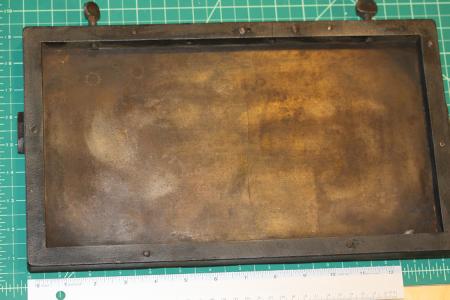
Chase
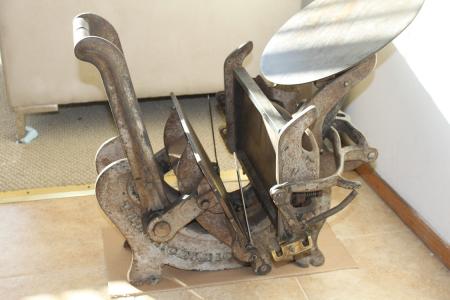
Side view with rollers taken off
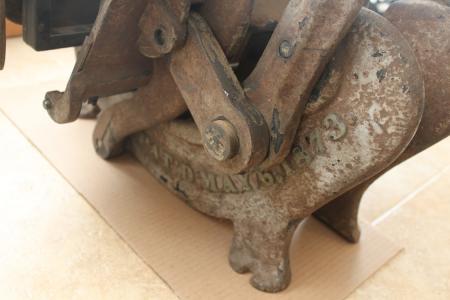
Writing on the side
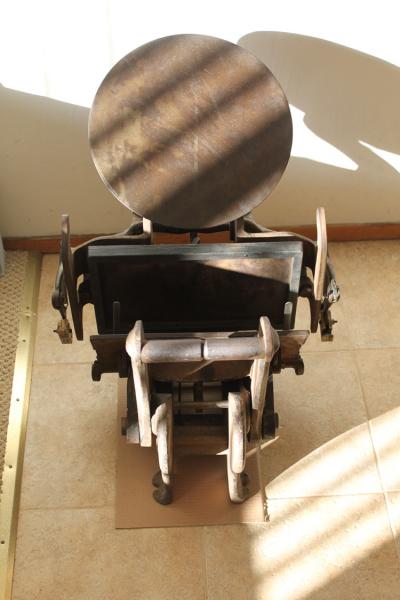
With chase inserted
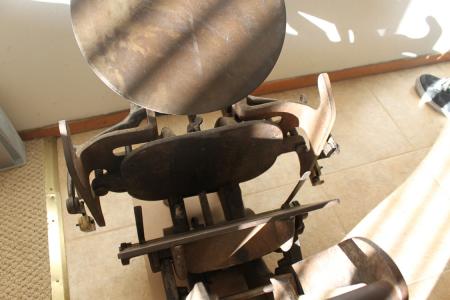
Chase removed
Your press was probably made after 1878 and before 1894. It is a No. 4 1/2 and has a boat body. Rollers and trucks will have to be specially made. What else did you want to know.
Regards,
Paul
Don’t know where you are located, but you should contact Alan at Excelsior Press in New Jersey, he has forgotten more about these presses than most of us will ever know. He rebuilds the kelseys and has parts from time to time. Good Luck Dick G.
Oh, thanks for the information Paul.
I’m basically wondering if this thing could be used for printing with impression (nothing crazy) given that the proper precautions (such as a suitable paper, dampening etc.) have been taken? Also, how hard would it be to get a hold of a replacement chase, would I have to get one made by sending the chase to someone that could replicate it, or would I be able to locate one if i keep my eye out on the usual sites? The one I have has a hairline crack (visible in the photo) that I’m assuming has been welded or repaired somehow, although I haven’t cleaned it to get a great look at it… would be nice to have a back-up if possible.
Also, if I decide to give this a proper clean, would it be advisable to disassemple it, or would that be a bad idea given it’s age and (I’m guessing) relative rarity?
-Kim
Dick, I’m located in San Francisco, I’ll send Alan an email and ask if he might be able to help…
I’m still overwhelmed at the helpful attitude and knowledge of the letterpress community, you guys are great!
-Kim
The press should be able to print with impression. In order to get it to that point will require an investment of money and time. It is probably more of a show piece at this time in its life.
The chases are rarer than hens teeth. On most of these types of presses the chase is missing.
If you plan to restore it, it will be a labor of love. You will never get the value you put into back out. If disassembled, take a lot of photos before taking off each part and label them right, left, front or back. These presses were fitted together by hand.
Hope this helps.
Regards,
Paul
My suggestion: Measure the center-to-center spacing on each roller saddle unit, subtract about 1/8 inch, and that is your maximum roller diameter. Measure the outside to outside distance between the saddles, across the press, and that is the minimum length of the cores. Measure the width of the saddle notches or journals, which are the bearings for the roller cores, and that will be the diameter of the cores. Hopefully that dimension is an even fraction of an inch (5/16, 3/8. 7/16, etc). Buy some drill rod that diameter at your local well-stocked hardware store and cut two lengths of it to the core length. Choose a roller diameter that is a standard measure, probably 1” or 1-1/4” or so, depending on the first measurement. Send these cores to Duro Roller and for about $150 or so they will make very nice rubber rollers about 30-40 durometer on the cores; the rubber should be about the length of the diameter of the ink disc or about 1/2 inch less than the inside measurement between the roller rails. When you get them back, have four roller trucks made of nylon or Delrin the exact same diameter as the rubber of the rollers. Put your new rollers on the press and get to printing!
If you can find someone who knows about brazing cast iron, you could have the crack on the chase brazed to strengthen it — but the cast iron has to be pre-heated to prevent heat stress cracking it again.
Bob
Value is subjective, right? And a working press can print value…
I have no doubt it will print when I get new rollers, but I’m forseeing a lot of trial and error before the results are where I want them to be, that’s part of the experience.
As to restoration, I’m thinking a good cleaning and coating of rust-protection, I’m in no way qualified to repaint it. My main worry with disassemply is that everything is connected with steel pins, and I’m wary of starting to tap them out. If I end up doing that, I’m guessing I should soak them in penetrating oil to ensure things go as smooth as possible?
There are several clues that someone has fixed this press up later in it’s life… I’m thinking someone has already disassembled it and put it back together, as the steel pins look fairly fresh and they don’t look like machined part, more like steel-rods of the right diameter that were just cut to fit. Whoever did that also fitted a new connection between the press and the rollers, the one that is on there now seems to be a DIY solution made from welded brass, connected to the press by a similarly fresh machine-screw. The rollers themselves were set up with springs to keep them in line.
I’m probably not going to start cleaning it until next weekend… What would be the first point of attack? I’ve read about scrubbing down the ink-disc, platen and chase-bed with a scotch-brite pad and wd-40? Or should I soak the chase and ink-disc in a lemon/lime and vinegar solution and rub them down with rust-protection after I’ve dried them off? Any cleaning advice based on what you can see in the images would be very helpful.
-Kim
Bob,
Fritz at NA Graphics is sending me a diagram of the measurements he needs to make new rollers and trucks… Thanks for your advice still, I’m getting more and more positive about getting this right.
I love this place.
-Kim
Contacted Alan, who told me that he actually had a chase in his shop that matched, that belonged to a recently restored press of this type. Currently I’m looking to have one or two chases machined (I know someone that will do it for shipping costs)… I’ve also gotten a lot of advise from other sources and hopefully I’ll get the rollers shipped off tomorrow.
Been very busy the last weeks, so I haven’t gotten around to cleaning yet. I’ve read several threads on cleaning presses, but I want to make sure I’ve got everything right before I start… The order of attack if you will.
So:
I’ll soak the removable parts, ink disc, adjustment bolts (they look like they need a good cleaning) and chase, in lemon-juice and white vinegar, how many parts of each? Should I clean the them first using WD-40 and a scrubbing pad?
What should I use for the rest of the press, more WD-40 and scrubbing? Use pad, steel wool or wire brush, all of the above? :) Removing paint is not an issue, as I’m pretty sure this thing has been repainted at least once before so there’s really nothing to save.
Thanks,
Kim